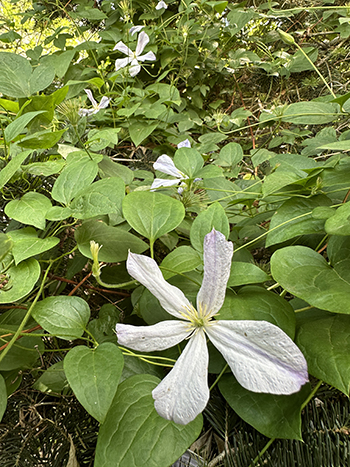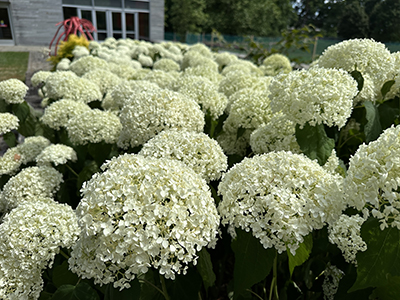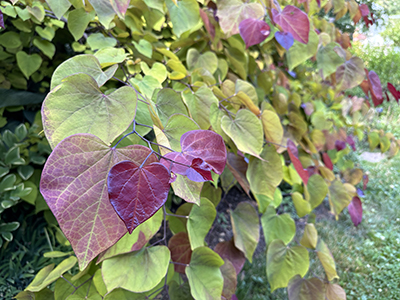
Plants of the Week: June 17
Guest Author: Seamus Lewin, 2024-2025 Public Horticulture Intern

Clematis ‘Dutch Sky’ (clematis)
Clematis ‘Dutch Sky’ can be found in a few places throughout the Arboretum, including in the corner of the John W. Nason Garden closest to Pearson Hall. Here it grows through Abies nordmanniana ssp. equi-tojani (trojan fir.) The blue and white flowers caught my eye while walking through the garden.
This cultivar of clematis was selected for its unique flower colors, which range from white to blue to light violet. The flowers have 4 to 6 uniform tepals, as well as yellow stamens in the center. True blue is typically very difficult to find in nature, so I have a special appreciation for the beauty of this cultivar aptly named after the sky. Clematis ‘Dutch Sky’ is a plant I recommend planting in your garden for its eye-catching beauty.

Hydrangea arborescens ‘Annabelle’ (smooth hydrangea)
Located in the corner of the Gold Medal Plants Garden, the cheery, rounded inflorescences of Hydrangea arborescens ‘Annabelle’ greet students each time they leave the Alice Paul Residence Hall, so I thought it was only fair that I share them with you, too.
In summer, Hydrangea arborescens ‘Annabelle’ bears a large number of 8-12 inch diameter inflorescences that are pure white. These flowers remain attractive until September, making them a perfect garden plant for the entire summer season.
Hydrangea arborescens is native to the river banks of the eastern United States and grows best in partial shade with morning sun. To encourage the best floral display, prune Hydrangea arborescens in late winter. They bloom on ‘new wood’ or current season’s growth.
If you like flower arrangements, Hydrangea arborescens is a great plant for your garden as its flowers can be cut and used in fresh or dry arrangements. Hydrangea arborescens ‘Annabelle’ was selected for its relatively compact growth, making it an ideal choice as a border plant.

Cercis canadensis ‘NC2016-2’ (Flame Thrower® eastern redbud)
Cercis canadensis (eastern redbud) is an unmistakable tree. Known for its heart-shaped leaves and pink to purple flowers, this species thrives across most of the United States. While there are quite a few redbuds throughout the Arboretum, I am struck by Flame Thrower® eastern redbud’s beauty daily as I work in and around the Terry Shane Teaching Garden.
This cultivar is unique because its leaves emerge as a deep purple and quickly turn to red as they expand. From there, leaves transition to reddish-orange and ultimately end up somewhere between yellow and green. This type of color transition is usually only seen in the fall, but it is a signature quality of Flame Thrower®. All leaves are in different stages of development at any particular point in time, allowing the tree to display a dynamic mix of colors.
Cercis canadensis is perfect for any mid to small size garden, but these plants do not transplant well, so choose a partially shaded location with little disturbance.





No Comments